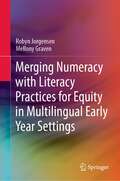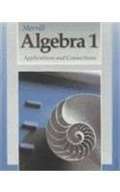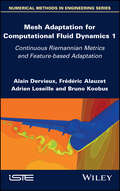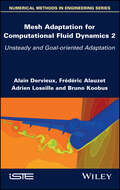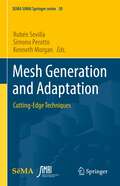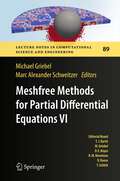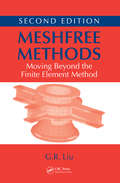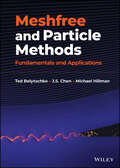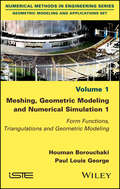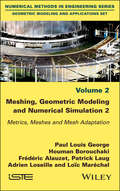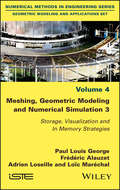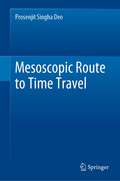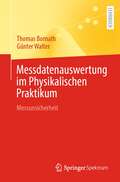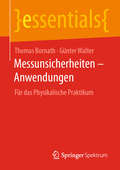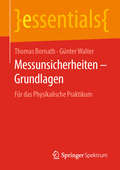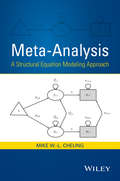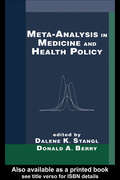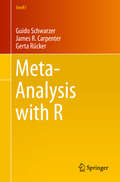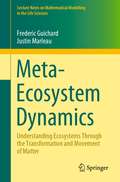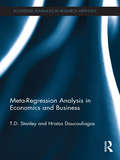- Table View
- List View
Merging Numeracy with Literacy Practices for Equity in Multilingual Early Year Settings
by Robyn Jorgensen Mellony GravenThis book draws on both in and out of school literacy practices with teachers and families to enhance the numeracy of early learners. It provides highly illustrative exemplars, targeted for learners up to approximately eight years of age whose home language differs from the language of instruction. It identifies the challenges faced by these learners and their families, and shares ways of building both literacy and numeracy skills for some of the vulnerable learners nationally and internationally.The book shares the outcomes and strategies for teaching mathematics to early years learners and highlights the importance of literacy practices for learners for whom the language of instruction is different from their home language. Readers will gain a practical sense of how to create contexts, classrooms and practices to scaffold these learners to build robust understandings of mathematics.
Merrill Algebra 1
by FosterDr. Miles Bennett discovers that his patients' strange behavior is due to an invasion of giant alien "pods," which are taking over the bodies of Santa Mira's citizens as they sleep.
Merrill Algebra 2 with Trigonometry: Applications and Connections
by Glencoe McGraw-Hill StaffAlgebra textbook
Mesh Adaptation for Computational Fluid Dynamics, Volume 1: Continuous Riemannian Metrics and Feature-based Adaptation
by Frederic Alauzet Adrien Loseille Alain Dervieux Bruno KoobusSimulation technology, and computational fluid dynamics (CFD) in particular, is essential in the search for solutions to the modern challenges faced by humanity. Revolutions in CFD over the last decade include the use of unstructured meshes, permitting the modeling of any 3D geometry. New frontiers point to mesh adaptation, allowing not only seamless meshing (for the engineer) but also simulation certification for safer products and risk prediction.Mesh Adaptation for Computational Dynamics 1 is the first of two volumes and introduces basic methods such as feature-based and multiscale adaptation for steady models. Also covered is the continuous Riemannian metrics formulation which models the optimally adapted mesh problem into a pure partial differential statement. A number of mesh adaptative methods are defined based on a particular feature of the simulation solution.This book will be useful to anybody interested in mesh adaptation pertaining to CFD, especially researchers, teachers and students.
Mesh Adaptation for Computational Fluid Dynamics, Volume 2: Unsteady and Goal-oriented Adaptation
by Frederic Alauzet Adrien Loseille Alain Dervieux Bruno KoobusSimulation technology, and computational fluid dynamics (CFD) in particular, is essential in the search for solutions to the modern challenges faced by humanity. Revolutions in CFD over the last decade include the use of unstructured meshes, permitting the modeling of any 3D geometry. New frontiers point to mesh adaptation, allowing not only seamless meshing (for the engineer) but also simulation certification for safer products and risk prediction.Mesh Adaptation for Computational Dynamics 2 is the second of two volumes and introduces topics including optimal control formulation, minimizing a goal function, and extending the steady algorithm to unsteady physics. Also covered are multi-rate strategies, steady inviscid flows in aeronautics and an extension to viscous flows.This book will be useful to anybody interested in mesh adaptation pertaining to CFD, especially researchers, teachers and students.
Mesh Generation and Adaptation: Cutting-Edge Techniques (SEMA SIMAI Springer Series #30)
by Kenneth Morgan Simona Perotto Rubén SevillaThe developments in mesh generation are usually driven by the needs of new applications and/or novel algorithms. The last decade has seen a renewed interest in mesh generation and adaptation by the computational engineering community, due to the challenges introduced by complex industrial problems.Another common challenge is the need to handle complex geometries. Nowadays, it is becoming obvious that geometry should be persistent throughout the whole simulation process. Several methodologies that can carry the geometric information throughout the simulation stage are available, but due to the novelty of these methods, the generation of suitable meshes for these techniques is still the main obstacle for the industrial uptake of this technology.This book will cover different aspects of mesh generation and adaptation, with particular emphasis on cutting-edge mesh generation techniques for advanced discretisation methods and complex geometries.
Meshfree Methods for Partial Differential Equations IX (Lecture Notes in Computational Science and Engineering #129)
by Michael Griebel Marc Alexander SchweitzerThis volume collects selected papers presented at the Ninth International Workshop on Meshfree Methods held in Bonn, Germany in September 2017. They address various aspects of this very active research field and cover topics from applied mathematics, physics and engineering.The numerical treatment of partial differential equations with meshfree discretization techniques has been a very active research area in recent years. While the fundamental theory of meshfree methods has been developed and considerable advances of the various methods have been made, many challenges in the mathematical analysis and practical implementation of meshfree methods remain.This symposium aims to promote collaboration among engineers, mathematicians, and computer scientists and industrial researchers to address the development, mathematical analysis, and application of meshfree and particle methods especially to multiscale phenomena. It continues the 2-year-cycled Workshops on Meshfree Methods for Partial Differential Equations.
Meshfree Methods for Partial Differential Equations VII
by Michael Griebel Marc Alexander SchweitzerMeshfree methods, particle methods, and generalized finite element methods have witnessed substantial development since the mid 1990s. The growing interest in these methods is due in part to the fact that they are extremely flexible numerical tools and can be interpreted in a number of ways. For instance, meshfree methods can be viewed as a natural extension of classical finite element and finite difference methods to scattered node configurations with no fixed connectivity. Furthermore, meshfree methods offer a number of advantageous features which are especially attractive when dealing with multiscale phenomena: a priori knowledge about particular local behavior of the solution can easily be introduced in the meshfree approximation space, and coarse-scale approximations can be seamlessly refined with fine-scale information. This volume collects selected papers presented at the Seventh International Workshop on Meshfree Methods, held in Bonn, Germany in September 2013. They address various aspects of this highly dynamic research field and cover topics from applied mathematics, physics and engineering.
Meshfree Methods: Moving Beyond the Finite Element Method, Second Edition
by G.R. LiuUnderstand How to Use and Develop Meshfree TechniquesAn Update of a Groundbreaking WorkReflecting the significant advances made in the field since the publication of its predecessor, Meshfree Methods: Moving Beyond the Finite Element Method, Second Edition systematically covers the most widely used meshfree methods. With 70% new material, this edit
Meshfree and Particle Methods: Fundamentals and Applications
by Ted Belytschko J. S. Chen Michael HillmanMeshfree and Particle Methods Provides thorough coverage of essential concepts and state-of-the-art developments in the field Meshfree and Particle Methods is the first book of its kind to combine comprehensive, up-to-date information on the fundamental theories and applications of meshfree methods with systematic guidance on practical coding implementation. Broad in scope and content, this unique volume provides readers with the knowledge necessary to perform research and solve challenging problems in nearly all fields of science and engineering using meshfree computational techniques. The authors provide detailed descriptions of essential issues in meshfree methods, as well as specific techniques to address them, while discussing a wide range of subjects and use cases. Topics include approximations in meshfree methods, nonlinear meshfree methods, essential boundary condition enforcement, quadrature in meshfree methods, strong form collocation methods, and more. Throughout the book, topics are integrated with descriptions of computer implementation and an open-source code (with a dedicated chapter for users) to illustrate the connection between the formulations discussed in the text and their real-world implementation and application. This authoritative resource: Explains the fundamentals of meshfree methods, their constructions, and their unique capabilities as compared to traditional methods Features an overview of the open-source meshfree code RKPM2D, including code and numerical examples Describes all the variational concepts required to solve scientific and engineering problems using meshfree methods such as Nitsche’s method and the Lagrange multiplier method Includes comprehensive reviews of essential boundary condition enforcement, quadrature in meshfree methods, and nonlinear aspects of meshfree analysis Discusses other Galerkin meshfree methods, strong form meshfree methods, and their comparisons Meshfree and Particle Methods: Fundamentals and Applications is the perfect introduction to meshfree methods for upper-level students in advanced numerical analysis courses, and is an invaluable reference for professionals in mechanical, aerospace, civil, and structural engineering, and related fields, who want to understand and apply these concepts directly, or effectively use commercial and other production meshfree and particle codes in their work.
Meshing, Geometric Modeling and Numerical Simulation 1: Form Functions, Triangulations and Geometric Modeling
by Houman Borouchaki Paul Louis GeorgeTriangulations, and more precisely meshes, are at the heart of many problems relating to a wide variety of scientific disciplines, and in particular numerical simulations of all kinds of physical phenomena. In numerical simulations, the functional spaces of approximation used to search for solutions are defined from meshes, and in this sense these meshes play a fundamental role. This strong link between the meshes and functional spaces leads us to consider advanced simulation methods in which the meshes are adapted to the behaviors of the underlying physical phenomena. This book presents the basic elements of this meshing vision.
Meshing, Geometric Modeling and Numerical Simulation 2: Metrics, Meshes and Mesh Adaptation
by Houman Borouchaki Paul Louis George Frederic Alauzet Patrick Laug Adrien Loseille Loic MarechalTriangulations, and more precisely meshes, are at the heart of many problems relating to a wide variety of scientific disciplines, and in particular numerical simulations of all kinds of physical phenomena. In numerical simulations, the functional spaces of approximation used to search for solutions are defined from meshes, and in this sense these meshes play a fundamental role. This strong link between meshes and functional spaces leads us to consider advanced simulation methods in which the meshes are adapted to the behaviors of the underlying physical phenomena. This book presents the basic elements of this vision of meshing. These mesh adaptations are generally governed by a posteriori error estimators representing an increase of the error with respect to a size or metric. Independently of this metric of calculation, compliance with a geometry can also be calculated using a so-called geometric metric. The notion of mesh thus finds its meaning in the metric of its elements.
Meshing, Geometric Modeling and Numerical Simulation 3: Storage, Visualization and In Memory Strategies
by Paul Louis George Adrien Loseille Frédéric Alauzet Loïc MaréchalTriangulations, and more precisely meshes, are at the heart of many problems relating to a wide variety of scientific disciplines, and in particular numerical simulations of all kinds of physical phenomena. In Volume 1, the theoretical foundations relating to triangulations, finite element shape functions and their interpretations as geometric patches were explored. This has made it possible to build tools that make the geometric modeling of any object possible. These elements are used in Volume 2 to treat meshing problems in their different implementations. Meshing, Geometric Modeling and Numerical Simulation 3 offers technical additions to the methods seen in the first two volumes and a significant portion of this book is dedicated to mesh visualization problems and solutions, especially those with a high degree of complexity.
Mesoscopic Route to Time Travel
by Prosenjit Singha DeoThis book gives a general introduction to theoretically understand thermodynamic properties and response to applied fields of mesoscopic systems that closely relate to experiments. The book clarifies many conceptual and practical problems associated with the Larmor clock and thus makes it a viable approach to study these properties. The book is written pedagogically so that a graduate or undergraduate student can follow it. This book also opens up new research areas related to the unification of classical and quantum theories and the meaning of time. It provides a scientific mechanism for time travel which is of immense fascination to science as well as society. It is known that developments in mesoscopic physics can lead to downscaling of device sizes. So, new or experienced researchers can have a quick introduction to various areas in which they might contribute in the future. This book is expected to be a valuable addition to the subject of mesoscopic physics.
Messdatenauswertung im Physikalischen Praktikum: Messunsicherheit
by Thomas Bornath Günter WalterIn diesem Lehrbuch wird der Umgang mit Messdaten und ihren Unsicherheiten in knapper und anschaulicher Weise auf der Grundlage aktueller, international standardisierter Methoden (GUM: ISO/IEC 98-3:2008) dargestellt. Zum leichteren Verständnis wird der Leser in einem einleitenden Kapitel in die Grundlagen der Statistik und Wahrscheinlichkeitsrechnung mit Hilfe von anschaulichen Beispielen eingeführt. Es werden grundlegende Kenntnisse über das Wesen von Messabweichungen, über Messunsicherheit und Wahrscheinlichkeitsverteilung, die Bestimmung der kombinierten und erweiterten Messunsicherheit und über Ausgleichsrechnung vermittelt. Der Hauptteil des Buches ist auf die Auswertung von Messdaten zur unmittelbaren Anwendung im Physikalischen Praktikum gerichtet. Für die wesentlichen Typen von Messaufgaben findet der Leser eine Zusammenstellung aller nötigen Formeln zur Bestimmung des Bestwertes und der kombinierten und erweiterten Messunsicherheit sowie praktische Hinweise für die Ermittlung von Unsicherheiten nach Typ B (nichtstatistische Methode).Zahlreiche durchgerechnete Beispiele geben konkrete Anleitungen und demonstrieren, wie die Ergebnisse ins Praktikumsprotokoll eingehen und wie sie diskutiert werden.Das vorliegende Kompendium ist sowohl für Studierende in einem Bachelor- oder Lehramtsstudiengang Physik als auch für Studierende in natur- und ingenieurwissenschaftlichen Studiengängen mit Nebenfach Physik geeignet.
Messunsicherheiten – Anwendungen: Für das Physikalische Praktikum (essentials)
by Thomas Bornath Günter WalterIn diesem Buch wird die Auswertung von Messdaten mit ihren Unsicherheiten für die Anwendung im Physikalischen Praktikum dargestellt. Für die wesentlichen Typen von Messaufgaben findet der Leser eine Zusammenstellung aller nötigen Formeln zur Bestimmung des Bestwertes und der kombinierten und erweiterten Messunsicherheit sowie praktische Hinweise für die Ermittlung von Unsicherheiten nach Typ B (nichtstatistische Methode). Zahlreiche durchgerechnete Beispiele geben konkrete Anleitungen und demonstrieren, wie die Ergebnisse ins Praktikumsprotokoll eingehen und wie sie diskutiert werden. Das vorliegende Kompendium ist sowohl für Studierende in einem Bachelor- oder Lehramtsstudiengang Physik als auch für Studierende in natur- und ingenieurwissenschaftlichen Studiengängen mit Nebenfach Physik geeignet.
Messunsicherheiten – Grundlagen: Für das Physikalische Praktikum (essentials)
by Thomas Bornath Günter WalterIn diesem Buch wird der Umgang mit Messdaten und ihren Unsicherheiten in knapper und anschaulicher Weise dargestellt. Im „Leitfaden zur Angabe der Unsicherheit beim Messen“ (ISO/IEC 98-3:2008) sind die Terminologie und die Methoden für die Behandlung von Messunsicherheiten international standardisiert. Auf dieser Grundlage werden dem Leser Kenntnisse über das Wesen von Messabweichungen, über Messunsicherheit und Wahrscheinlichkeitsverteilung, die Bestimmung der kombinierten und erweiterten Messunsicherheit und über Ausgleichsrechnung vermittelt.Das vorliegende Kompendium ist sowohl für Studierende in einem Bachelor- oder Lehramtsstudiengang Physik als auch für Studierende in natur- und ingenieurwissenschaftlichen Studiengängen mit Nebenfach Physik geeignet.
Meta Math!: The Quest for Omega
by Gregory ChaitinIn Meta Math!, Gregory Chaitin, one of the world’s foremost mathematicians, leads us on a spellbinding journey of scientific discovery and illuminates the process by which he arrived at his groundbreaking theories. All of science is based on mathematics, but mathematicians have become painfully aware that math itself has serious limitations. This notion was first revealed in the work of two giants of twentieth-century mathematics: Kurt Gödel and Alan Turing. Now their successor, Gregory Chaitin, digs even deeper into the foundations of mathematics, demonstrating that mathematics is riddled with randomness, enigmas, and paradoxes. Chaitin’s revolutionary discovery, the Omega number, is an exquisitely complex representation of unknowability in mathematics. His investigations shed light on what, ultimately, we can know about the universe and the very nature of life. But if unknowability is at the core of Chaitin’s theories, the great gift of his book is its completely engaging knowability. In an infectious and enthusiastic narrative, Chaitin introduces us to his passion for mathematics at its deepest and most philosophical level, and delineates the specific intellectual and intuitive steps he took toward the discovery of Omega. In the final analysis, he shows us that mathematics is as much art as logic, as much experimental science as pure reasoning. And by the end, he has helped us to see and appreciate the art––and the sheer beauty––in the science of math. In Meta Math!, Gregory Chaitin takes us to the very frontiers of scientific thinking. It is a thrilling ride. From the Hardcover edition.
Meta-Analysis
by Mike W.-L. CheungPresents a novel approach to conducting meta-analysis using structural equation modeling. Structural equation modeling (SEM) and meta-analysis are two powerful statistical methods in the educational, social, behavioral, and medical sciences. They are often treated as two unrelated topics in the literature. This book presents a unified framework on analyzing meta-analytic data within the SEM framework, and illustrates how to conduct meta-analysis using the metaSEM package in the R statistical environment. Meta-Analysis: A Structural Equation Modeling Approach begins by introducing the importance of SEM and meta-analysis in answering research questions. Key ideas in meta-analysis and SEM are briefly reviewed, and various meta-analytic models are then introduced and linked to the SEM framework. Fixed-, random-, and mixed-effects models in univariate and multivariate meta-analyses, three-level meta-analysis, and meta-analytic structural equation modeling, are introduced. Advanced topics, such as using restricted maximum likelihood estimation method and handling missing covariates, are also covered. Readers will learn a single framework to apply both meta-analysis and SEM. Examples in R and in Mplus are included. This book will be a valuable resource for statistical and academic researchers and graduate students carrying out meta-analyses, and will also be useful to researchers and statisticians using SEM in biostatistics. Basic knowledge of either SEM or meta-analysis will be helpful in understanding the materials in this book.
Meta-Analysis for Psychologists
by Richard CookeThis textbook provides a comprehensive, user-friendly guide to meta-analysis and how to conduct it, using open source software and based on examples commonly found in the field of psychology. Meta-analysis is a key tool used in systematic literature reviews to synthesize research findings across studies, but despite being relatively straightforward to perform, it remains underused by psychologists. In the first section the reader is introduced to key ideas that underlie meta-analysis and how it might be best employed. Following this the reader is guided through how to run a meta-analysis of correlational studies and experimental studies using the free and open statistical software JAMOVI. In the concluding section Professor Cooke considers common issues, key debates and examines the relative merits of different analyses and different software packages.Covers theory, key issues and step-by-step demonstrationsIncludes examples worked examples familiar to psychologists and datasetsCompanion videos demonstrate the methods outlinedIt will provide a valuable new resource for postgraduate students and researchers in the behavioural and social sciences looking to enhance their methodological skills.
Meta-Analysis in Medicine and Health Policy (Chapman & Hall/CRC Biostatistics Series)
by Donald A. Berry Dalene K. StanglThis remarkable text raises the analysis of data in health sciences and policy to new heights of refinement and applicability by introducing cutting-edge meta-analysis strategies while reviewing more commonly used techniques. Each chapter builds on sound principles, develops methodologies to solve statistical problems, and presents concrete applications used by experienced medical practitioners and health policymakers. Written by more than 30 celebrated international experts, Meta-Analysis in Medicine and Health Policy employs copious examples and pictorial presentations to teach and reinforce biostatistical techniques more effectively and poses numerous open questions of medical and health policy research.
Meta-Analysis with R
by Guido Schwarzer James R. Carpenter Gerta RückerThis book provides a comprehensive introduction to performing meta-analysis using the statistical software R. It is intended for quantitative researchers and students in the medical and social sciences who wish to learn how to perform meta-analysis with R. As such, the book introduces the key concepts and models used in meta-analysis. It also includes chapters on the following advanced topics: publication bias and small study effects; missing data; multivariate meta-analysis, network meta-analysis; and meta-analysis of diagnostic studies.
Meta-Analysis: Methods for Health and Experimental Studies (Statistics for Biology and Health)
by Shahjahan KhanThis book focuses on performing hands-on meta-analysis using MetaXL, a free add-on to MS Excel. The illustrative examples are taken mainly from medical and health sciences studies, but the generic methods can be used to perform meta-analysis on data from any other discipline. The book adopts a step-by-step approach to perform meta-analyses and interpret the results. Stata codes for meta-analyses are also provided. All popularly used meta-analytic methods and models – such as the fixed effect model, random effects model, inverse variance heterogeneity model, and quality effect model – are used to find the confidence interval for the effect size measure of independent primary studies and the pooled study. In addition to the commonly used meta-analytic methods for various effect size measures, the book includes special topics such as meta-regression, dose-response meta-analysis, and publication bias. The main attraction for readers is the book’s simplicity and straightforwardness in conducting actual meta-analysis using MetaXL. Researchers would easily find everything on meta-analysis of any particular effect size in one specific chapter once they could determine the underlying effect measure. Readers will be able to see the results under different models and also will be able to select the correct model to obtain accurate results.
Meta-Ecosystem Dynamics: Understanding Ecosystems Through the Transformation and Movement of Matter (Lecture Notes on Mathematical Modelling in the Life Sciences)
by Frederic Guichard Justin MarleauThis book presents current meta-ecosystem models and their derivation from classical ecosystem and metapopulation theories. Specifically, it reviews recent modelling efforts that have emphasized the role of nonlinear dynamics on spatial and food web networks, and which have cast their implications within the context of spatial synchrony and ecological stoichiometry. It suggests that these recent advances naturally lead to a generalization of meta-ecosystem theories to spatial fluxes of matter that have both a trophic and non-trophic impact on species. Ecosystem dynamics refers to the cycling of matter and energy across ecological compartments through processes such as consumption and recycling. Spatial dynamics established its ecological roots with metapopulation theories and focuses on scaling up local ecological processes through the limited movement of individuals and matter. Over the last 15 years, theories integrating ecosystem and spatial dynamics have quickly coalesced into meta-ecosystem theories, the focus of this book. The book will be of interest to graduate students and researchers who wish to learn more about the synthesis of ecosystem and spatial dynamics, which form the foundation of the theory of meta-ecosystems.
Meta-Regression Analysis in Economics and Business (Routledge Advances In Research Methods Ser. #5)
by Hristos Doucouliagos T.D. StanleyThe purpose of this book is to introduce novice researchers to the tools of meta-analysis and meta-regression analysis and to summarize the state of the art for existing practitioners. Meta-regression analysis addresses the rising "Tower of Babel" that current economics and business research has become. Meta-analysis is the statistical analysis of previously published, or reported, research findings on a given hypothesis, empirical effect, phenomenon, or policy intervention. It is a systematic review of all the relevant scientific knowledge on a specific subject and is an essential part of the evidence-based practice movement in medicine, education and the social sciences. However, research in economics and business is often fundamentally different from what is found in the sciences and thereby requires different methods for its synthesis—meta-regression analysis. This book develops, summarizes, and applies these meta-analytic methods.
